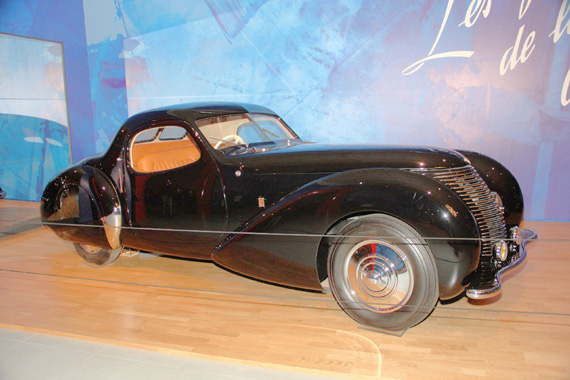
A 1949 Pourtout Delahaye is now part of the Louwman collection in The Hague Netherlands. Photo by Hugues Vanhoolandt.
By Gijsbert-Paul Berk
Of our Three Musketeers, only two survived the war. But despite all odds, both Pourtout and Darl’mat continued to create interesting designs well into the 1950s.
Georges Paulin and the Resistance
While it was sad that the Rolls-Royce Paulin Corniche was destroyed at Dieppe, even more tragic is the fact that Georges Paulin did not survive the war. After Hitler’s troops marched into Paris, Paulin joined the French resistance group Albi, which supplied information to British Intelligence. He produced drawings of German installations and armament and transmitted information using a clandestine radio transmitter. Sadly the activities of the Albi cell were betrayed by people working within the Vichy government for the Deuxième Bureau (the French Military Intelligence Service) to the Abwehr (the German Military Intelligence Service). Georges Paulin, Jacques Kellner, a famous Parisian carrossier and president of the French Coachbuilders Association and Roger Raven, a friend of Paulin who worked at Carrosserie Pourtout and was also part of the Albi resistance group, were arrested and sentenced to death by a German Military Tribunal. Paulin was nearly 40 years old; when on 21 March 1942 he was executed by a firing squad at the fortress of Mount Valérien. In 1944 the government of Charles de Gaulle posthumously awarded Georges Paulin the Medaulle Militaire et Citation à l’Ordre de l’Armée.
Pourtout in the post-war era
During the occupation Carrosserie Pourtout was confiscated by the Germans, who used its workshops and painting facilities to repair army vehicles. When the American troops and the 2nd Armored Division of the Free French army under Général Leclerc advanced to liberate Paris, the retreating German army badly damaged and plundered the buildings. Nearly all the equipment had disappeared.
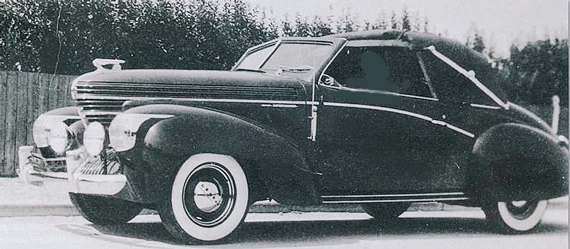
Because of their reputation with series production Carrosserie Pourtout was commissioned by the French importer of the American Graham-Page cars to convert a number of their ’Sharknose’ business coupés into elegant cabriolets. According to Claude Pourtout a few of these cars were re-exported to the US.
Marcel Pourtout was now 50 and when he looked back to the carefree prewar past he also remembered that the last years before the war, the number of private customers who commissioned one-off special bodies on an expensive chassis had drastically diminished. Thanks to their experience with series production and their reputation with the special bodied Lancias, the French importer of Graham-Page automobiles had given them an order to transform a number of these Sharknosed American cars into elegant convertibles. In the autumn of 1939 they also had built 22 ambulance trucks on Chevrolet chassis for the American Volunteer Corps.
If his sons Claude and Marcel Jr. had not insisted, it is not certain that Marcel Sr. would have had the courage to recommence. Because he was also major of Rueil-Malmaison, and the responsibilities of that function that were no sinecures in those postwar days.
Claude Pourtout, then barely 20, became the driving force in the family enterprise. During the dark years of the war he had followed evening courses for coachwork design and construction, organized by the French Chambre Syndicale des Carrossiers. Because it was very difficult to obtain new chassis some of the clients of coachbuilders such as Pourtout asked them to transform their prewar car with a new and modern body. Claude again and again proved to have the talents to follow in the footprints of both his father and Georges Paulin. He not only directed the recovery of the workshop by taking on repair work but also personally designed some very attractive bodies on Delahaye, Simca and Talbot. As a boy he had often looked over Paulin’s shoulders, while he was drawing. And this, he admitted, had taught him a lot about the art of styling. According to Claude Pourtout Georges Paulin was a very gentle man and always took the time to explain to him what he was doing and why. So it is not that strange that his creations showed the same refined elegance.
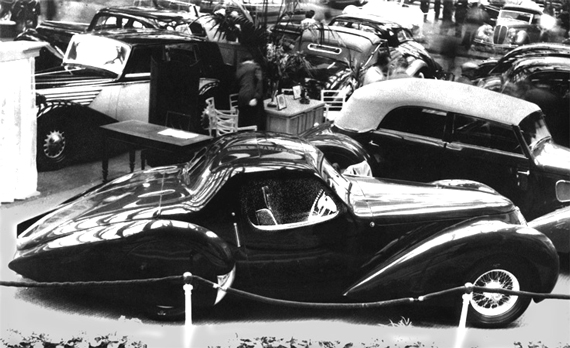
At their stand on the 1949 Salon de l’Automobile in the Grand Palais in Paris, Carrosserie Pourtout displayed this attractive Delahaye coupé. Claude Pourtout designed it.
In 1948 Marcel Sr. was reelected as major of Rueil-Malmaison, retired from Carrosserie Pourtout, named Claude (1925 – 2004) as his successor and gave him control of the company. From 1947 until 1952 Carrosserie Pourtout still exhibited its latest designs at the yearly Paris Salon de l’Automobile and their coachwork also won many prizes at the various Concours d’Elegance.
But during the 1950s the well-known French manufacturers of expensive chassis for passenger cars one after the other of ceased production or went bankrupt. As Claude Pourtout realized, that there was only a future in building special coachwork for commercial vehicles, Carrosserie Pourtout became one of the leading specialists for promotional vehicles. These ingeniously designed trucks and trailers functioned as mobile and movable advertisements, presentation stages and sales rooms. They were used at the markets and festivals of rural France and in the publicity caravans that accompanied the popular bicycle races in that country, such as the Tour de France and similar events.
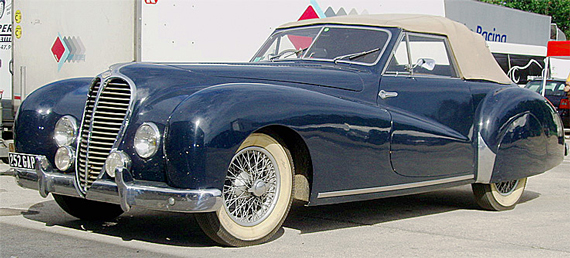
Claude Pourtout also designed the body of this Pourtout cabriolet on a Delahaye 135 chassis. It shows some influence of contemporary American styling such as the 1948 Buick Roadmaster Convertible But it is devoid from all the chrome embellishments GM in Detroit deemed necessary.
But television gradually changed the habits of the French population and TV spots attracted a greater share of the publicity budgets. This naturally had a negative effect on the demand for promotional vehicles. However, Carrosserie Pourtout had earned itself quite a reputation with their construction and for this reason they were even engaged in building the upper structures of the first Bateaux Mouches; the famous floating restaurants that cruise the river Seine in Paris. Sadly, in July 1994 financial difficulties forced Claude Pourtout to abandon construction work. One of his sons took over Carrosserie Pourtout, now a specialist body repair shop in the Rue des Jacinthes at Rueil-Malmaison.
The name Pourtout was not only highly respected in the world of automobile body construction but also in that of governing bodies: Marcel Pourtout was elected for three times as major of Rueil-Malmaison and also became President of the Conseil Général de Seine-et-Oise. His son Claude Pourtout was elected as Vice-President of the Fédération Française de la Carrosserie, in charge of the heritage (patrimoine). Later he became Honorary Member of this organization.
Darl’mat after the war
On 25 August 1944 the German garrison in the French capital surrendered; that same day Emile Darl’mat repossessed his garages and resumed his activities. There was a shortage of everything and there were of course, except for a few American cars imported from the US (to be paid with Dollars), no new automobiles to be had. However, the retreating German army had left a lot of non- running vehicles behind (some were booby-trapped) and since 1940 many French owners had hidden their automobiles in farm sheds, cellars or attics. Now all these cars required reconditioning or restoring, to be fit again for use on the road. Therefore most French repair shops were thriving and there was a brisk trade in spare parts and second hand motors.
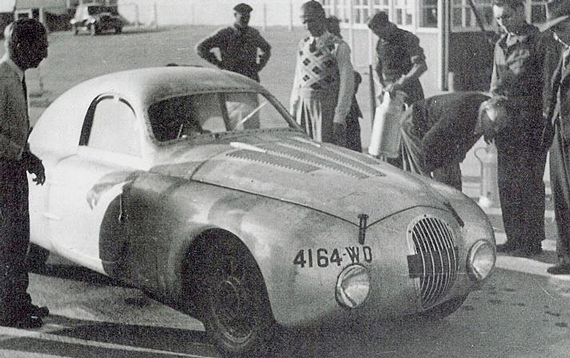
When in 1945 Peugeot resumed the production of their small 202 saloons, Emile Darl'mat used the mechanical parts of this model to develop in his own workshop a streamlined lightweight coupe. This car broke several records at Montlhéry and had a place of honor on the Peugeot stand at the Paris Motor Show.
When Peugeot recommenced manufacturing and marketing their prewar 202 saloons, Emile Darl’mat developed in his own body repair shop a sleek and aerodynamic fastback coupé using the mechanical parts of this model. In 1947 this 202 Darl’mat 202 Spécial broke at Montlhéry three speed records for the under 1100 cc category: 1,000 miles (1,609 km) at an average speed of 144.5 km/h (89.8 mph), 2,000 Miles (3,218 km) at an average speed of 145.0 km/h (90.1 mph) and 12 hours at an average of 144.5 km/h (89.8 mph). Its average fuel consumption during this record attempt turned out to be 10.l/100 km (23.3 mpg.). Although the 202 Darl’mat attracted great interest on the Peugeot stand at the Paris motor show in October it never got any follow up.
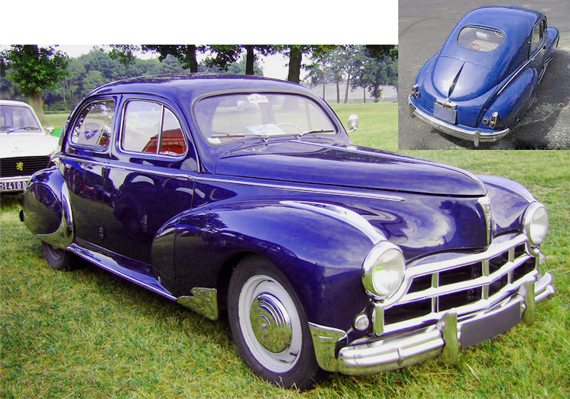
It is evident that the 203 Darl'mat was based on the standard Peugeot 203 saloon. But the Darl’mat was 14 cm. lower and had a ‘souped up’ engine. On the insert one can see the small and purely decorative fin on the tail.
That was quite different with the 203 Darl’mat, based on the new four-door fastback Peugeot model. Darl’mat’s recipe was to reduce the cars height some 14-centimeter by using shorter coil springs and lower the fastback roofline applying the same methods, as some customizers in the U.S. in those days, when they chopped and lowered the roofs of Detroit iron. To differentiate the cars even more from the standard 203’s the Darl’mat’s had a very small dorsal fin on the rear of the body. The engine performance was increased to 50 bhp by raising the compression ratio and fitting a special intake manifold and two carburetors. All these modifications gave the 203 Darl’mat a better acceleration and top speed of over 140 Km/h (87 Mph). From 1949 up till 1954 Darl’mat produced around 150 of these attractive cars.
Emile Darl’mat in 1953 asked Geo Ham (pseudo of Georges Hamel) a well-known French painter and illustrator of automobiles to design for him an elegant pontoon body for a two-door coach. Dalr’mat intended have a number of such bodies made in plastic (fiberglass moldings), using his 203 Darl’mat components for the mechanical parts. But when he was invited in April 1955 for the dealer introduction of the 403 he decided to switch to the larger engine of this new model. At the Paris Motor show in October 1955 he presented this Peugeot 403 based sports coupé.
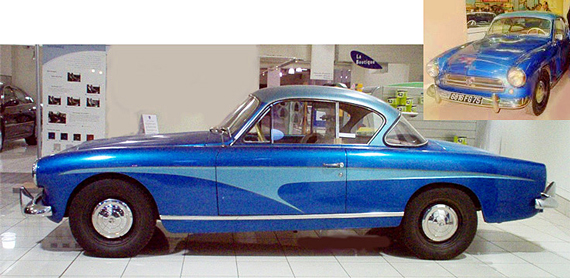
There is little doubt that Geo Ham, the famous French painter and illustrator of automobiles, who in 1953 designed the body of the 403 Dar’mat, was somehow inspired by the 1952/1953 Studebaker coupé. Emile Darl’mat presented the model on the 1955 Paris Motor Show. The insert shows the front-end treatment.
It was a nice looking car but he sold only 5 of them. Not only because it was quite expensive but also because in the meantime the Peugeot factory had concluded an agreement with Pininfarina in Turin to become their styling consultant and build their future sporting coupé and cabriolet models in Italy. This convinced Emile Darl’mat that it would be more lucrative to concentrate his time and energy on selling the cars that Peugeot produced. Darl’mat continued to work at expanding his dealership until his death in 1970. In May 1975 the company was taken over by Peugeot as a ‘succursale’ (subsidiary) and is now active as Société Commerciale Automobile Peugeot Darl’mat, with a network of sales outlets and service centers in the Paris area.
PERSONAL DATES
Émile Darl’mat (1892 – 1970)
Marcel Pourtout (1894 -1979)
Georges Paulin (1902 – 1942)
Claude Pourtout (1925 – 2004)
BIBLIOGRAPHY
Magazine: Thorougbred & Classic Cars – February 1984.
‘The ill fated Bentley Corniche’ – Pages 34 – 35.
Author: James Fack
Magazine: Thorougbred & Classic Cars – July 1985.
‘Streamliner’ (The Embricos Bentley) – Pages 52 – 47.
Author: Brian Palmer
Magazine: Automobilia – No. 14 – June 1997 – pages 40 – 47
La Carrosserie Pourtout, ‘Audace et Elégance’ (1925 – 1940)
Author: Giles Bonnafous
Magazine: Automobilia – No. 17 – September 1997 – pages 41 – 47
La Carrosserie Pourtout, ‘Les Derniers Feux de Rueil’
Author: Alexandre Legrand
Magazine: Retroviseur No. 20
Marcel Pourtout, ‘Un Roi de la Carrosserie’ (Vécu).
Magazine: Retroviseur No. 21
Marcel Pourtout. ‘Un Roi de la Carrosserie’ (Vécu) suite.
Book: From Passion to Perfection, ‘The story of French Streanlined styling’.
Author: Richard Addato, photography by Jean-Paul Carron
Published by: SPE Barthélemy, Paris – 2003
ISBN: 2-912838-22-3
Book: Itérinaire d’un home libre, ‘ des ‘fortifs’ à la capponière du mont Valérien’.
Author: Michel-George Paulin
Published by: SPE Barthélemy, Paris – 2003
ISBN: 2-912838-25-8
Book: Darl’mat, ‘des Peugeot d’exception’.
Author: Cornée Laurent
Published by: ETAI, Paris – 2014
ISBN : 978-2-7268-0004-3
Marvelous account; well written and packed with information. Thank you.